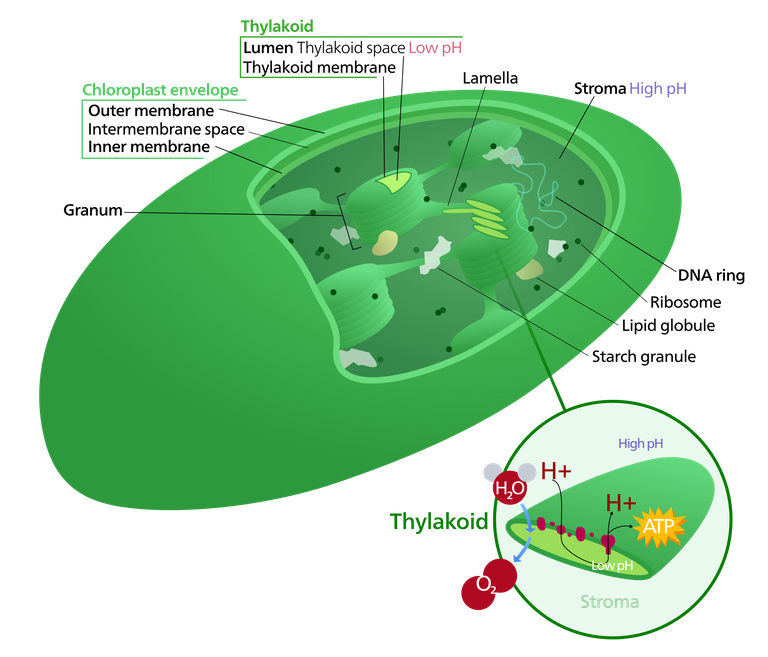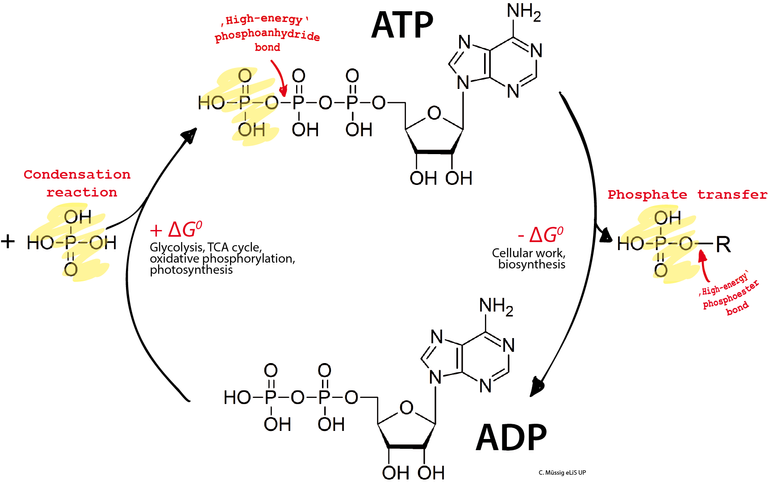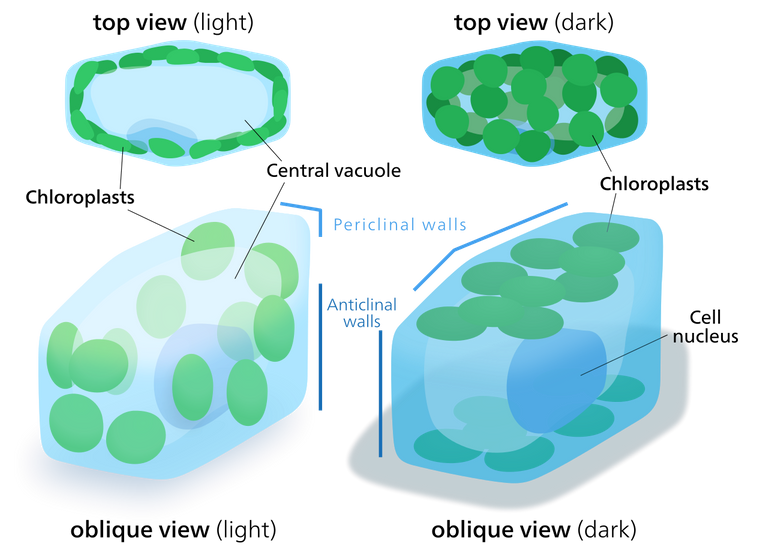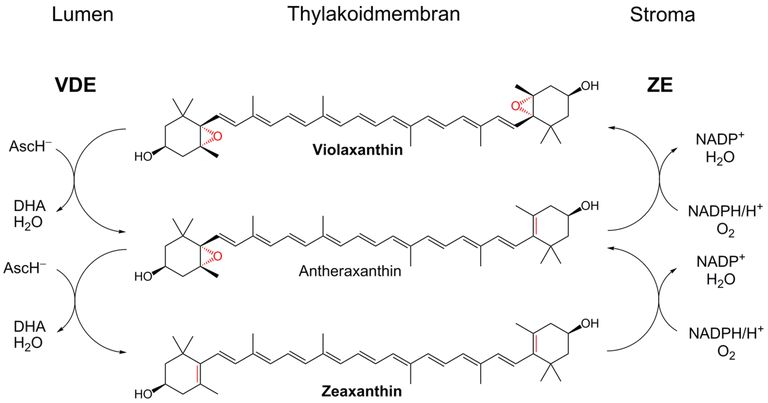Since my previous article looked at some ways plants detect light, I thought it might be fun to look at what happens when plants get too much sunlight. If you've ever wondered what happens to shade plants when put into full sun, you'll probably find this interesting.
The specific questions we'll look at are:
How are plants damaged by sunlight, and how do they protect themselves?
The general outline for answering these questions is:
- Photosynthesis Refresher
- How Does Excess Light Causes Damage?
- How Do Plants Protect Themselves?
Photosynthesis Refresher
We need to start this journey in the chloroplast, so here is a reference figure to orient yourself:

First, we need to consider that photosynthesis converts light energy into chemical energy. This process happens on the thylakoid membrane in the chloroplast during the light-dependent reactions as shown below:

During the light reactions photosystems I and II absorb energy which is used to concentrate hydrogen ions inside the thylakoids(i.e. in the thylakoid lumen). The result is potential energy, because the concentration of hydrogen ions is higher inside the thylakoid than outside [1].
The chloroplast takes advantage of the potential energy as these ions flow out of the thylakoid. The only path for them to exit is through a protein called ATP synthase. As the ions pass through, ATP synthase harnesses the potential energy to create adenosine triphosphate(ATP) from ADP and phosphate. ATP is then used as a source of chemical energy to power remaining steps of photosynthesis [1].

How Does Excess Light Causes Damage?
Since sunlight is a form of energy, it makes sense that too much of it would cause some damage to the plant. This is similar to what you would expect if you plugged your computer into a greater power source than it was designed for.
The first line of damage occurs when the energy absorbed by chlorophyll cannot be directed toward photosynthesis. When this happens, the chlorophyll molecule can react with oxygen to form singlet oxygen [2]. These singlet oxygen molecules are very reactive and can cause major damage to components in the cell [3].
Another type of damage can occur if protein complexes absorbing light energy for photosynthesis are damaged. This directly results in a reduction in photosynthetic capability. When this happens it is called photoinhibition, because the photosynthetic process is inhibited by the damage [4]. The most vulnerable photosynthetic component is photosystem II which is a complex composed of many proteins as shown below:
The most vulnerable protein is named D1 [1][2]. Once the D1 proteins are damaged, it reduces the ability of the plant to concentrate the hydrogen ions inside the thylakoid lumen. So, the photosynthetic rate will be reduced, since it cannot use the potential energy to create ATP.
The only way for the plant to recover is to remove the damaged D1 proteins from the PSII complex and create new ones from scratch [1]. This can take sometime for a plant to recover from photoinhibition and it could very well die before it fully recovers.
How Do Plants Protect Themselves?
Plants evolved to be solar powered, so it's no surprise that they have some clever ways to avoid damage from too much solar energy hitting them. I'll be breaking these down into short-term responses and long-term responses focusing on developmental responses.
Short-Term Strategies
Chloroplast Movement
Even though plants are sessile organisms, it doesn't mean that parts of them can't move. For example, chloroplasts within leaves can actually be moved around! So, one simple way plants avoid excess light is to simply reduce the surface area of exposed chloroplasts by moving them within the leaves [5].

Heat Dissipation
Once excess light is hitting the chloroplasts, it's possible to just transform that absorbed energy into heat to remove it from the system. All of the mechanisms involved have not been elucidated and confirmed yet, but we can look at one of the more prominent examples discovered so far. It involves pigment molecules called carotenoids. These are the same class of molecules that give carrots their color.

More specifically, a subclass of carotenoids called xanthophylls are involved in a process that converts excess energy into heat. The system consists of three xanthophyll molecules called violaxanthin, antheraxanthin, and zeaxanthin. Enzymes can interconvert these molecules forming a cycle[6]:
violaxanthin --> antheraxanthin --> zeaxanthin
The cycle goes from violaxanthin to zeaxanthin under high light and backwards under low light. There is evidence that zeaxanthin can release heat when it interacts with excited chlorophyll molecules [7].

Long-Term Strategies
There are also some strategies plants use to acclimate to living in environments with high sun. Acclimation refers to changes in the development of a plant to optimize to its environment.
One response is to change the shape of its leaves. Typically, leaves acclimated to high light conditions will be thicker than shade leaves [1]. I think this makes sense if you think back to the chloroplast movement example above. There are probably other reasons this is helpful as well though.
Another way plants acclimate to high light conditions is to adjust the concentrations of chlorophyll and xanthophyll in their leaves. Leaves acclimatd to high light often have lower concentrations of chlorophyll and higher concentrations of xanthophylls compared to shade leaves [1].
Thank you for reading and I hope everyone has a great evening.
Sources
Images
Chloroplast diagram: https://commons.wikimedia.org/wiki/File:Chloroplast_(borderless_version)-en.svg
Thylakoid membrane diagram: https://commons.wikimedia.org/wiki/File:Thylakoid_membrane_3.svg
ATP cycle: https://fr.m.wikipedia.org/wiki/Fichier:ADP_ATP_cycle.png
Photosystem II: https://commons.wikimedia.org/wiki/File:Photosystem-II_2AXT.PNG
Chloroplast movement: https://commons.wikimedia.org/wiki/File:Chloroplast_movement.svg
Carrot: https://commons.wikimedia.org/wiki/File:Carrot-fb.jpg
Xanthophyll cycle: https://commons.wikimedia.org/wiki/File:Violaxanthin_cycle.png
References
[1] Taiz, Lincoln, et al. Plant Physiology and Development. Sinauer Associates, Inc., Publishers, 2015.

We are soon gonna be learning these lovely cycles and reactions in the biochemistry course. Can not wait. Great post!
I’m glad you enjoyed the article! Have fun in your course. :)
@servusminervae, I have a question on the likelihood of sun damage.
What kind of environment (you mentioned high sun) are we talking about where sun damage becomes a factor to consider?
This question depends greatly on the plant species involved and in what conditions they have been grown in. Different plant species have different abilities to acclimate to high sunlight levels which depends on their genes. Shade plants are specialized for low light conditions, and don’t have the genetic „programs“ which can allow them to acclimate to high light levels. So, shade plants can be damaged by direct sunlight under any growing conditions.
On the other hand, sun plants are able to grow in full sunlight without any problems under normal conditions. However, they might still experience negative effects if the amount of sunlight hitting them is more than can be used for photosynthesis. These plants might experience high light stress under conditions like drought, because the maximum rate of photosynthesis is less.
The past growing conditions can also have an effect on the potential for experiencing high light stress. If you have a plant which has the ability to grow in both shady and full sun conditions, it will become acclimated to whatever environment you place it in. For example, the number, size, and shape of the leaves might be optimized to the current growing conditions. On the biochemical level, the amount of xanthophyll and chlorophyll will also be optimized.
If we grow this hypothetical plant inside, it will acclimate to those conditions of low light using some of these methods. If we then suddenly take it outside in full sunlight, it could very well experience high light stress before it fully adapts to the new conditions (consider things like leaf shape/number would take a long time to change).
Amazing. I often think about how we can use these self-protective and self regulating features in nature to improve businesses or designs in the "human world." I'm resteeming and upvoting this. 😀 😃 😄 😁 😆 Thanks again for sharing...and don't forget to keep steeming OK?
I'm glad you enjoyed the post. Thanks for the support.
You're welcome. Thank you for your kind words! I hope you have a WONDERFUL WONDERFUL day!! Where are you from?
I hope you have a wonderful day as well. :) I'm from the USA.
Cool where I studied in Boston
I know this is off topic but can we use plant to terraform mars because mars atmosphere composed of 95% co2?
I've actually done some research on this for my "Mars" series that recently ended.
Yes, we could use plants to terraform Mars but it would take a bit. The start would be with resistant lichens and mosses and then work up to more complicated plants as the oxygen content rises. An atmosphere would form bit by bit and the temperature would increase.
That implies, of course, that somebody is overseeing that and constantly introducing the right plants all over the planet.
Interesting. I'm resteeming and upvoting this. 😀 😃 😄 😁 😆 Thanks again for sharing...and don't forget to keep steeming OK?
Earth is home.
Everywhere else is fantasy land.
And will be for a Loooooooooong time.
Hi @kizzbonez. I honestly don’t know what difficulties we might run into trying to grow plants in space. I think you would have to grow them in some type of structure on mars. I did read this article a while back about some work NASA was doing regarding growing plants that I’ll share with you.
https://www.nasa.gov/feature/nasa-plant-researchers-explore-question-of-deep-space-food-crops
Upvoted and also resteemed :]
Thanks for the support!
You did so much researching :) Congratulations! @curie upvote your post .
I'm glad you enjoyed the post.
Congratulations @servusminervae, this post is the most rewarded post (based on pending payouts) in the last 12 hours written by a Dust account holder (accounts that hold between 0 and 0.01 Mega Vests). The total number of posts by Dust account holders during this period was 2238 and the total pending payments to posts in this category was $422.93. To see the full list of highest paid posts across all accounts categories, click here.
If you do not wish to receive these messages in future, please reply stop to this comment.
Congratulations @servusminervae!
Your post was mentioned in the hit parade in the following category: